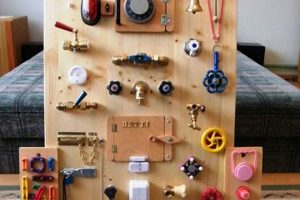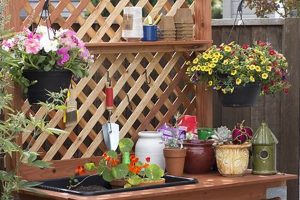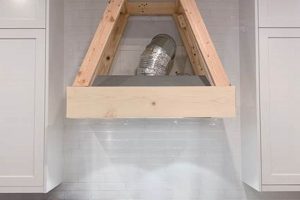A self-assembled floral framework, typically used as a decorative element at events such as weddings or garden parties, involves the construction of an archway adorned with fresh, dried, or artificial flowers. The creation of such a structure often relies on readily available materials and basic construction techniques, allowing individuals to personalize the aesthetic to their specific tastes and event themes. For instance, a simple frame constructed from metal pipes can be embellished with climbing roses and greenery secured with floral wire.
The appeal of crafting such decorative features stems from the opportunity for cost savings relative to professional floral arrangements, as well as the inherent satisfaction derived from personalizing event decor. Historically, floral arches have symbolized prosperity, fertility, and celebration in various cultures, making their presence at significant life events a deeply rooted tradition. Furthermore, the selection of specific blooms can imbue the structure with deeper symbolic meaning, reflecting the values and sentiments of those celebrating.
The following sections will detail the materials required for construction, offer step-by-step instructions for assembling a stable and visually appealing framework, and provide guidance on selecting and arranging floral elements to achieve a cohesive and impressive design. These considerations are crucial for success.
Essential Considerations for a Self-Assembled Floral Archway
Constructing a structurally sound and aesthetically pleasing floral arch requires careful planning and attention to detail. The following guidelines offer valuable insights to ensure a successful outcome.
Tip 1: Foundation Stability: Prioritize a robust frame capable of withstanding wind and the weight of the floral arrangements. Metal piping or treated lumber, securely anchored, are recommended to prevent collapse.
Tip 2: Floral Selection Alignment: Harmonize bloom choices with the overarching event theme. Consider color palettes, bloom sizes, and the longevity of fresh flowers to maintain visual appeal throughout the occasion. For example, a rustic-themed event may benefit from wildflowers, while a formal wedding could feature roses and hydrangeas.
Tip 3: Attachment Method Security: Employ robust attachment methods like floral wire, cable ties, or specialized floral adhesive to secure the floral elements to the frame. Periodic checks and reinforcement may be necessary, especially with fresh blooms.
Tip 4: Gradual Construction Process: Avoid overloading the frame with excessive weight at any single point. Distribute floral elements evenly, building density gradually to maintain structural integrity.
Tip 5: Environmental Factors Mitigation: Understand environmental conditions. Direct sunlight can accelerate wilting, while high winds can dislodge floral elements. Implement preventative measures like shade provision or windbreaks as needed.
Tip 6: Proportionality Maintenance: Ensure the archway’s dimensions are proportionate to the surrounding environment. An arch that is too small will be visually insignificant, while an overly large one will overwhelm the space.
Tip 7: Pre-Event Assembly Trial: Conduct a full-scale trial assembly before the actual event. This allows for identification of potential structural weaknesses or aesthetic imbalances, facilitating necessary adjustments.
Adhering to these recommendations optimizes structural soundness and aesthetic appeal. Doing so elevates the presence and lasting impact of the floral element.
The subsequent section will detail the post-event handling of the completed floral arch. Considerations like dismantling and proper floral element disposal will be addressed.
1. Structure
The structural integrity of a self-assembled floral archway directly dictates its stability, longevity, and overall safety. In the context of a do-it-yourself project, the choice of materials and assembly techniques for the framework becomes paramount. A poorly constructed base will inevitably lead to collapse, damaging the floral arrangements and potentially posing a hazard to individuals in close proximity. For example, using thin PVC pipes in a windy environment, without proper anchoring, would render the entire structure unstable, irrespective of the quality or quantity of the floral decorations.
Considerations for the structure extend beyond mere load-bearing capacity. The design must facilitate efficient attachment of floral elements, potentially incorporating features like pre-drilled holes or integrated support systems. Moreover, the visual appearance of the frame itself should complement, rather than detract from, the floral design. This could involve painting the structure a neutral color or selecting materials that blend seamlessly with the natural setting. The weight distribution of the flowers must be considered within the framework design to ensure balance and prevent tipping. A top-heavy arrangement on a light frame is a recipe for disaster.
Ultimately, a comprehensive understanding of structural principles is crucial for anyone undertaking a floral archway project. The selection of appropriate materials, the implementation of secure assembly methods, and the careful consideration of weight distribution are all essential factors in ensuring a safe, durable, and aesthetically pleasing final product. Ignoring these structural aspects undermines the entire endeavor, irrespective of the beauty and quality of the floral elements themselves.
2. Blooms
The selection of blooms constitutes a critical determinant in the aesthetic success of a self-assembled floral arch. The specific flowers employed directly influence the arch’s visual impact, thematic resonance, and longevity. Ill-considered bloom selection can undermine the entire project, regardless of the structural soundness of the arch framework. For instance, the exclusive use of delicate, short-lived flowers in an outdoor arch exposed to direct sunlight would result in rapid wilting and diminished visual appeal within a few hours. Conversely, a selection of robust, weather-resistant blooms would maintain its integrity for an extended period.
The practical significance of understanding this connection lies in the ability to tailor the bloom selection to specific event requirements and environmental conditions. A formal wedding might necessitate the use of classic blooms like roses and hydrangeas, demanding meticulous attention to hydration and temperature control. A rustic garden party, on the other hand, could effectively incorporate wildflowers and foliage, requiring less stringent maintenance. Furthermore, bloom availability and cost factors must be considered. Sourcing out-of-season or rare blooms can significantly increase project expenses and potentially introduce logistical challenges. The strategic use of more affordable, readily available alternatives can achieve a similar aesthetic impact
without exceeding budgetary constraints. Consider the implications of incorporating artificial blooms. Doing so would address durability and cost, but the aesthetic effect should be considered.
In summary, the blooms utilized in a floral archway are not merely decorative elements but integral components that dictate its overall success. Careful consideration of factors such as flower type, longevity, environmental suitability, and cost is essential for achieving a visually appealing and sustainable final product. The challenge lies in balancing aesthetic preferences with practical limitations, ensuring that the chosen blooms complement the arch’s design and withstand the demands of the event and its surroundings. Failing to adequately address these factors increases the risk of creating an archway that fails to meet expectations or maintain its visual integrity throughout the intended duration.
3. Attachment
Within the context of a self-assembled floral arch, attachment refers to the methods and materials used to securely fasten floral elements to the structural framework. The effectiveness of this attachment directly influences the longevity, aesthetic integrity, and safety of the finished product. Inadequate attachment can lead to displacement of floral materials, causing the arch to appear incomplete or disheveled and, in severe cases, posing a safety risk if large components detach and fall. For instance, using weak adhesive to secure heavy flower heads to a metal arch would likely result in detachment over time, particularly in outdoor environments subject to wind or temperature fluctuations. A more robust attachment method, such as floral wire or cable ties, would provide a more secure and durable connection.
The practical significance of understanding attachment lies in the ability to select appropriate techniques and materials based on the specific characteristics of the floral elements and the structural framework. Lightweight flowers may be adequately secured with floral tape or glue, while heavier blooms or branches require stronger methods like wiring or bolting. Furthermore, the attachment method must consider the material composition of both the flowers and the framework. Attaching floral elements to a wooden frame presents different challenges than attaching them to a metal or PVC structure. Drilling small holes in the frame and using wire or twine can offer a secure and visually discreet attachment point in a wooden frame, whereas using adhesive or specialized clips may be more suitable for metal or PVC.
In summary, attachment is not merely a functional detail but a critical component that determines the overall success of a self-assembled floral archway. Careful selection of appropriate methods and materials, based on the weight and characteristics of the floral elements, the nature of the structural framework, and the environmental conditions, is essential for creating a durable, aesthetically pleasing, and safe final product. Neglecting this aspect can compromise the entire endeavor, resulting in an arch that is visually unappealing, structurally unsound, or potentially hazardous.
4. Arrangement
Arrangement, in the context of a self-assembled floral arch, refers to the strategic placement and organization of floral elements to achieve a desired aesthetic outcome. The specific arrangement significantly impacts the visual appeal, balance, and overall impact of the finished arch, determining whether it appears harmonious and professional or chaotic and amateurish.
- Symmetry and Asymmetry
Symmetrical arrangements create a sense of formality and balance, with identical floral displays mirrored on either side of the arch. Asymmetrical arrangements offer a more dynamic and modern aesthetic, using varying sizes, shapes, and types of flowers to create visual interest. For instance, a symmetrical arch might feature identical garlands of roses on each side, while an asymmetrical arrangement could incorporate a cascading wisteria vine on one side balanced by a cluster of hydrangeas on the other. The choice between symmetry and asymmetry depends on the event’s overall style and the desired visual effect; the impact on material quantity also changes.
- Color Palette and Contrast
The selection and arrangement of colors play a critical role in the arch’s visual impact. Monochromatic palettes offer a subtle and elegant effect, using varying shades of a single color. Contrasting colors create a bolder and more vibrant statement. A monochromatic arrangement might feature various shades of white and cream, while a contrasting palette could combine deep reds with bright yellows. Improper management of color contrast will lead to chaos. The thoughtful use of color enhances the arch’s overall aesthetic and complements the surrounding environment.
- Focal Points and Flow
Effective arrangements establish focal points that draw the eye and create visual interest. These focal points can be achieved through the strategic placement of larger blooms, contrasting colors, or unique textures. The arrangement should also create a visual flow, guiding the viewer’s eye along the arch’s structure and highlighting its key features. A focal point might consist of a cluster of large peonies at the center of the arch, with smaller flowers cascading down the sides to create a sense of flow. The absence of a focal point dilutes the arch’s visual impact.
- Texture and Depth
Incorporating a variety of textures and depths adds visual complexity and interest to the arrangement. Combining smooth petals with rough foliage, or layering different sizes and shapes of flowers, creates a richer and more dynamic aesthetic. A well-balanced arrangement utilizes varying textures to catch the light and create shadows, enhancing the overall visual appeal. This layering, in turn, leads to the perceived sense of depth. Combining textures and adding depth is essential for achieving a professional and visually engaging result.
The arrangement of floral elements within a self-assembled archway is not simply an afterthought but a fundamental aspect that dictates its aesthetic success. Careful consideration of symmetry, color, focal points, and texture is essential for creating a visually harmonious and impactful arch that enhances the overall event atmosphere. Effective arrangement elevates the arch from a mere structure adorned with flowers to a cohesive work of art.
5. Durability
Durability represents a critical factor in the successful execution of a self-assembled floral archway. The ability of the structure and its floral components to withstand environmental stressors and maintain their aesthetic integrity over a defined period is paramount. The following sections will detail several key facets that influence the overall durability of a floral arch.
- Material Selection
The choice of materials for both the structural framework and the floral elements directly impacts the arch’s longevity. Utilizing weather-resistant materials like treated lumber or powder-coated metal for the frame enhances its ability to withstand moisture, temperature fluctuations, and physical stress. Similarly, selecting durable floral varieties, or o
pting for high-quality artificial flowers, minimizes wilting, discoloration, and physical damage. The lifespan of an arch constructed with flimsy materials and delicate blooms will be significantly shorter than one built with robust components. - Structural Integrity
A structurally sound framework is essential for ensuring the arch’s long-term stability. Weak joints, inadequate anchoring, or an unstable base can compromise the entire structure, leading to collapse or deformation under the weight of the floral arrangements or exposure to wind. Reinforcing connection points, utilizing appropriate load-bearing supports, and anchoring the base securely are crucial for maximizing the arch’s lifespan. A properly engineered framework provides a stable foundation that protects the floral elements from unnecessary stress and damage.
- Environmental Factors
Exposure to environmental elements such as sunlight, wind, and moisture significantly impacts the durability of a floral arch. Direct sunlight can accelerate the fading and wilting of fresh flowers, while strong winds can dislodge floral elements or even topple the entire structure. Implementing protective measures, such as providing shade, using windbreaks, or selecting weather-resistant floral varieties, can mitigate these effects. Considering the specific environmental conditions of the event location is crucial for maximizing the arch’s lifespan and maintaining its visual appeal.
- Maintenance and Upkeep
Regular maintenance and upkeep contribute significantly to the long-term durability of a floral arch. Periodically checking the structural integrity of the framework, replacing wilted or damaged floral elements, and providing adequate hydration to fresh flowers can extend the arch’s lifespan and maintain its aesthetic integrity. Neglecting these maintenance tasks will inevitably lead to a decline in the arch’s visual appeal and structural stability. Consistent attention to detail ensures that the arch remains a visually stunning and structurally sound feature throughout the event.
These factors underscore the importance of carefully considering durability in the planning and construction of a self-assembled floral arch. By prioritizing material selection, structural integrity, environmental protection, and ongoing maintenance, it becomes possible to create an archway that not only looks beautiful but also withstands the test of time and environmental demands.
6. Aesthetics
Aesthetics, pertaining to the principles of beauty and artistic taste, forms a cornerstone in the design and construction of self-assembled floral archways. The archs visual appeal significantly influences the overall ambiance of an event and contributes to the aesthetic experience of attendees.
- Color Harmony
The strategic selection and combination of colors within the floral arrangement dictates the arch’s visual impact. Harmonious color palettes, employing analogous or monochromatic schemes, evoke a sense of tranquility and cohesion. Conversely, contrasting colors, when used judiciously, create visual interest and focal points. For example, a wedding arch might feature a palette of soft pastels, such as blush pink and lavender, to create a romantic and delicate atmosphere. An arch designed for a garden party could incorporate vibrant hues like yellow, orange, and fuchsia to create an energetic and celebratory ambiance.
- Floral Texture and Form
The interplay of textures and forms within the floral arrangement adds depth and visual complexity to the arch. Combining flowers with varying petal shapes, sizes, and surface textures creates a richer and more engaging aesthetic. Integrating foliage with different leaf shapes and textures further enhances the visual interest. An arch featuring roses with smooth, velvety petals alongside textured greenery such as eucalyptus or ferns demonstrates this principle. The absence of textural variation renders the arch visually flat and unappealing.
- Symmetry and Asymmetry
The balance of the floral arrangement, whether symmetrical or asymmetrical, significantly influences the arch’s aesthetic character. Symmetrical arrangements create a sense of formality and order, while asymmetrical arrangements offer a more dynamic and organic aesthetic. A symmetrical arch might feature identical floral arrangements on either side of the frame, while an asymmetrical design could incorporate a cascading floral display on one side balanced by a smaller cluster on the other. The chosen balance should reflect the style of the occasion.
- Proportionality and Scale
The relationship between the arch’s dimensions and the surrounding environment is critical to its aesthetic success. An arch that is too small will appear insignificant, while an arch that is too large will overwhelm the space. Similarly, the scale of the floral elements should be proportionate to the size of the arch. Using oversized blooms on a small arch creates a sense of imbalance. Careful consideration of proportionality and scale ensures that the arch harmonizes with its surroundings and creates a visually pleasing focal point.
These aesthetic considerations collectively contribute to the visual impact of a self-assembled floral archway. The successful integration of color harmony, floral texture, balance, and proportionality transforms a simple structure into a visually captivating centerpiece, enhancing the overall aesthetic experience of the event.
Frequently Asked Questions
The following addresses commonly encountered inquiries regarding the construction and maintenance of self-assembled floral archways. It provides concise and factual answers to aid in project planning and execution.
Question 1: What is the average lifespan of a self-assembled floral archway utilizing fresh flowers?
The lifespan is dependent on several factors, including floral variety, environmental conditions, and hydration practices. Generally, an archway using fresh flowers will maintain optimal visual appeal for 1-3 days.
Question 2: What structural materials are most suitable for constructing a durable floral archway frame?
Treated lumber, metal piping (steel or aluminum), or robust PVC are recommended. The choice depends on budget, desired aesthetic, and load-bearing requirements.
Question 3: How should floral elements be secured to the archway frame to ensure stability?
Floral wire, cable ties, and specialized floral adhesives are effective. The selection depends on the weight and type of floral material and the frame’s surface. Secure attachment is essential for mitigating detachment risk.
Question 4: What precautions are necessary when constructing a floral archway for outdoor use?
The frame must be adequately anchored to prevent toppling in wind. Select weather-resistant floral varieties or utilize artificial flowers. Consider potential sun exposure and implement shading measures if necessary.
Question 5: How can the overall cost of a self-assembled floral archway be minimized?
Utilize in-season blooms, source materials locally, and consider incorporating foliage and greenery to reduce reliance on expensive floral varieties. Explore the use of artificial flowers for select components.
Question 6: What are the key considerations for disassembling and disposing of a floral archway after an event?
Dismantle
the structure carefully, separating floral elements from the frame. Compost biodegradable materials responsibly. Recycle or repurpose the frame components when feasible. Adhere to local waste disposal regulations.
These answers provide a foundational understanding of critical aspects related to DIY floral archways. Careful consideration of these factors contributes to a more successful and satisfying project outcome.
The subsequent section will transition into providing expert tips for designing aesthetically pleasing and structurally sound archways.
DIY Flower Arch
This article has explored various facets of the “diy flower arch,” encompassing structural integrity, bloom selection, attachment methods, arrangement techniques, durability considerations, and aesthetic principles. Successful execution necessitates a comprehensive understanding of these elements to produce a visually appealing and structurally sound creation. The ability to balance aesthetic desires with practical limitations, such as budget and environmental factors, is critical.
The pursuit of a self-assembled floral archway demands meticulous planning and careful execution. A successful project transcends mere decoration, embodying a testament to craftsmanship and dedication. Diligence in design and construction assures a lasting contribution to any event.







